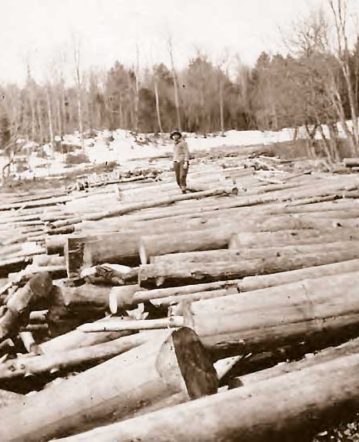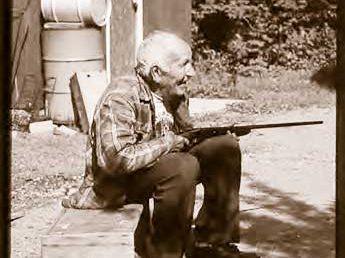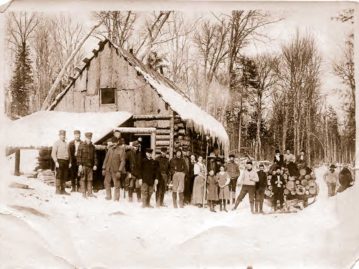Earl M. Kreuzer was among the oldest ’jacks I spoke with. One-by-one the loggers I have known, and some I have worked with, have “gone on.”

A Look Back In Time
A Memory for Earl
An article printed in “The Northern Logger “, June 2022
One-by-one the loggers I have known, and some I have worked with, have “gone on.” With their passing they took with them a love for the industry and their historical connection to the loggers who cruised woodlots, followed the timber, cut it down, bucked it up, hauled it to river landings, cared for horses and machinery, drove logs to the mill, sawed logs into lumber, and produced pulp from wood for paper products. Logging still goes on today but with a difference. The logs must be cut, skidded, chipped, and gotten to market, or mill, the same as ever. The great difference is in the change of tools: Chain saws, chippers, whole tree harvesters, skidders, and trucks for hauling, while in the years gone by the work was performed by man-and horsepower. While the colorful old-style ’jacks, fiercely proud teamsters, inventive blacksmiths, prima-donna cooks, log-hopping whitewater men and river hogs have passed on, logging goes forward. Meanwhile, their history continues to draw attention to their times.

Peeled logs, spring break-up. Earl’s voice revealed both the danger and excitement as he shared river driving tales on the West Canada “Crick.”
COURTESY LYONS FALLS HISTORICAL ASSOCIATION
The idea of cutting timber to make a living appealed to those I knew, as did knowing they belonged to the ranks of those who had preceded them – all a special breed of men, and yes, some women, who pitted their skills and talents against the forest lumberjacks and lumberjills. The generation I knew were not the “shanty-boys” of old – loggers from the “pineries,” the virgin timber of the Northeastern forests who practiced the old ways of traditional logging long before the new era of machinery.
I’m happy to say that among all the oldsters I’ve interviewed, not one shared their memories from their bed in a nursing home. All lived generally independently – with the same air of freedom they had experienced in the forests. It was their generation who knew first-hand the older “shanty boys.” And it was they who passed on the memories through songs, stories and vintage snapshots, many of which included in Adirondack Logging: Stories, Memories, Cookhouse Chronicles, Linn Tractors and Gould Paper Company History from the Adirondack and Tug Hill Lumber Camps (In the Adirondacks, 2016).
Earl M. Kreuzer was among the oldest ’jacks I spoke with. My memories of him come back each year as I pass the dirt road that leads to West Canada Creek at the turn-off from Route 8 just before Hoffmeister, N.Y. My remembrance of Earl is as special as my memories of all the folks who have opened their doors to me and shared a bit of their life – stories that help to add to an understanding of a time we can know about only when history is recorded. This memory is for you, Earl, and for all the other special souls who’ve given freely of their time to help preserve their era:
Every year the trout lie sleeping in still cold pools waiting for an Adirondack winter to change to the warmth of spring. With each cycle, new people find the old footpaths up mountains, around the edges of boggy ponds and alongside streams that twist toward distant lakes and rivers. This annual freshness has a history. Earl Kreuzer, also known as the Mayor of Hoffmeister, was part of that history. He traveled those Adirondack trails long before me, rode logs on the Hudson River and owned a general store. His father, a former lumberman, owned and operated the Henry Kreuzer Hotel in Morehouseville.
“You’ve got to talk to the Mayor,” I was told, to get the lowdown on the logging operations in the West Canada Creek basin. “Earl knows everything from way back. Besides, he has the best collection of old lumbering stuff around.”
My best memory of meeting him is the clouds of black flies and the smell of his house, best described as poorly-ventilated cigarette smoke plus old stuff, mixed with wood smoke. I made two trips to his small cabin along New York’s West Canada Creek. The interior was cluttered with relics of another time, hunting and fishing paraphernalia, old logging tools and memorabilia. Earl told nonstop stories – one after another. I loved those stories but I never grew used to the swarms of black flies or the perpetual cloud of cigarette smoke. I snapped a favorite photo of Earl on my last visit.

Earl M. Kreuzer was 93-years old when I interviewed him. His mind was as sharp as a tack. Linn tractor at Whitney Park.
Photo by WILLIAM J. O’HERN
“Want to see a trick?” he asked, following my comment that his well-cared for vegetable garden did not have a protective wire fence. For the life of me I didn’t understand how he protected the crops from the forest critters.
“Sure,” I replied. “What’re ya gonna do?”
Earl’s next moves sealed him in my folklore mind as a legendary hero of the Adirondacks. Earl picked up his .410 shot-gun, grabbed a handful of unshelled peanuts, sat down on a log stump at the edge of the garden, and laid the rifle across his lap. “Watch this,” he said as he placed a peanut on the top of his bald head. It was only a matter of minutes before a chipmunk appeared. Chippy darted toward Earl’s motionless body, raced up his side, grabbed the nut, poked it into his paunch and leaped off on a mad dash to who-knows-where.
Earl’s 90-plus-year-old body bolted to life. The years had not slowed his reaction time. As the animal scurried off, Earl raised his rifle, aimed and fired. “There!” he declared in a big way, “That’s how I keep my corn to myself.”
I didn’t think much of the slaughter, but Earl was giving me a bit of insight into the ways of the old-time people of the Adirondacks. His behavior was simply part of his Adirondack character. I rather doubt anyone consciously sets out to become a character. Character traits merely develop in accordance with one’s personality. There’s no recipe for being a colorful individual. The men and women I call characters are unique in their own way.
It’s the unique cut of the old-timers characters that I think also holds a special spot in my heart. It seems as if less individuality stands out in the trade today. And it’s that lack that makes nostalgia for the earlier days more powerful.
While the lumber industry has always had its ups and its downs, New York State has an abundance of woodland and will continue to produce men and women who have an interest in working in the commercial lumber industry in some capacity, from cruising timber to marketing the finished goods.
The logging cry Tim-BERRR! has always had a twofold meaning in logging jargon. Since the days when choppers traveled by the light of a lantern into the woods, it has been a warning call from the feller of a tree to all within the sound of his voice to be careful because a forest patriarch is hurtling down. Bellowed in a woods-worker’s tavern, it also was, and is to this day, a summons to all at hand to share in the caller’s generosity to “belly up to the bar.” For both reasons, that iconic word will continue to resonate in America’s woods and taverns, recalling a colorful past and promising a productive future.

A typical scene of a logging camp crew and cooks. Earl said the women cooks often had their children in camp. “Even the youngest kids helped in some ways.”
COURTESY PATTI BATEMAN QUINN

Earl was a witness to see the change from the old-style logging to the appearance of mechanical equipment. COURTESY DONALD WILLIAMS